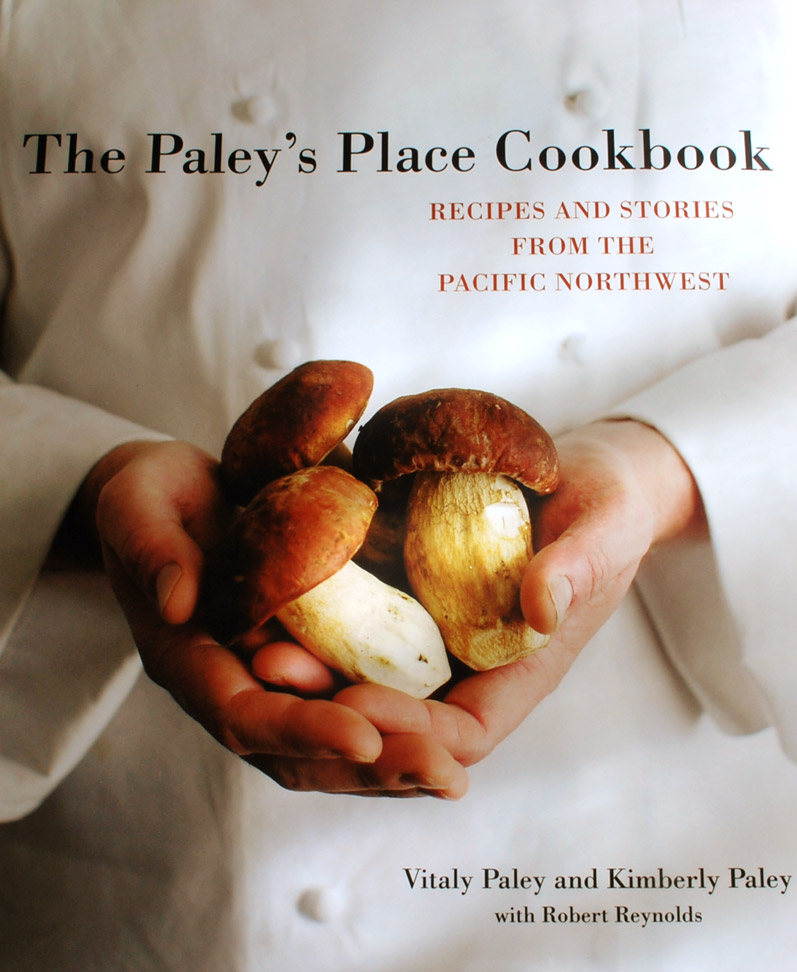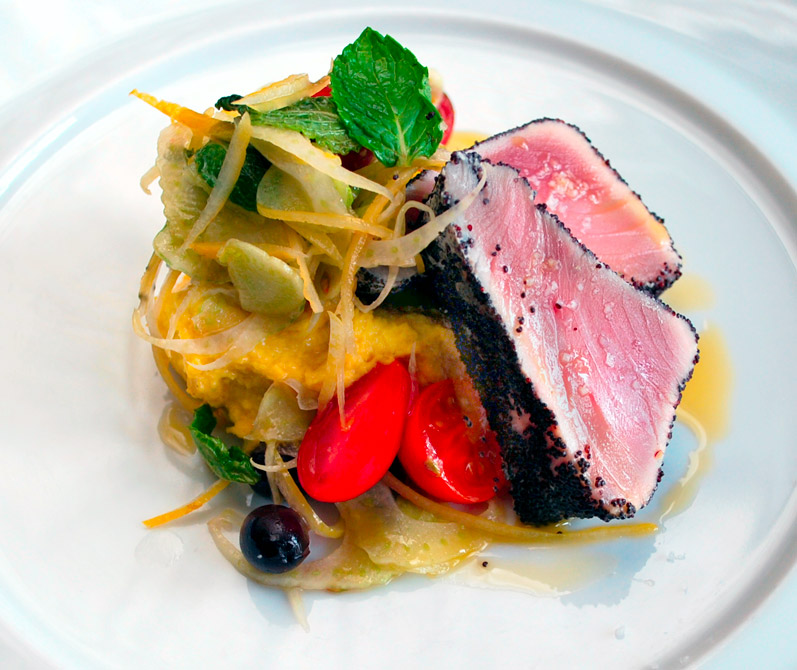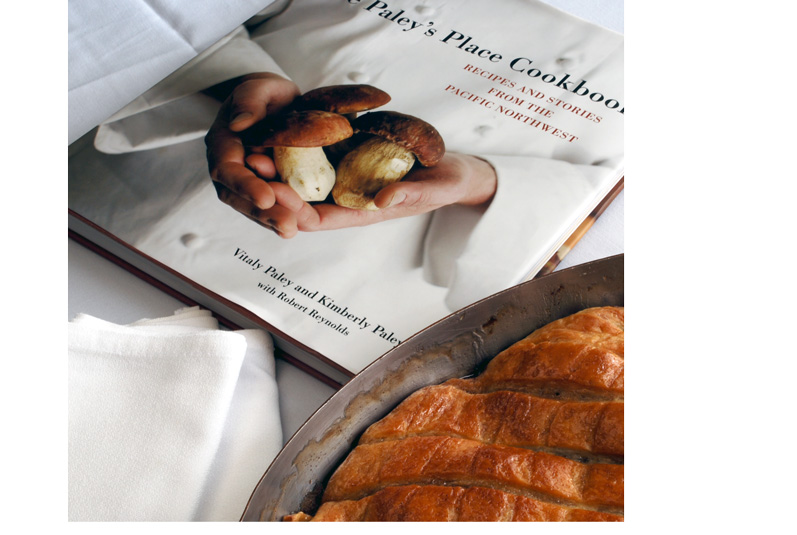I have a lot of cookbooks: hundreds, many hundreds, many many hundreds, who knows how many hundreds? I read them–voraciously and compulsively–like mystery novels, looking for clues. Clues to the artistic intention, vision, and personality behind the recipes and the rhetoric. A Voice with something unique to say–or if not unique, then honest, sincere, compelling, impassioned, or moving. I’m looking for the reason that I should care about what the writer has to say. The last thing I am interested in at this point is JUST another collection of recipes.
So let me state unequivocally here: The Paley’s Place Cookbook: Recipes and Stories from the Pacific Northwest is NOT just another collection of recipes. Quite the opposite, which also means quite the exception.
I recently spent a couple of spell-bound hours with Chef Vitaly Paley at his and Kimberly Paley’s restaurant, Paley’s Place, in Portland, Oregon. The conversation was lively, engaged, thoughtful, informed, sincere, down-to-earth, and intelligent–much like Chef Paley himself. It’s the same kind of conversation you will find running throughout this cookbook; stories about the people, land, sea, and commitment that form the foundation of Northwest cuisine. Not dry, factual stories, but stories rich in meaning and significance. And beautifully written.
I read the pre-release galleys of the book cover-to-cover over a few evenings, but was hooked on the first page with these two sentences:
“One July Fourth–the 100th birthday of the statue of Liberty—when our work was done for the night, we wound up making out under the shadows of the torch the old Dame held high. We remember fireworks.”
Vitaly Paley was talking about falling in love with the woman who was to become his wife, partner, and co-author of this book, Kimberly Paley. This partnership, between a Julliard-trained muscian, turned chef and a Martha Graham School-trained dancer, turned sommelier resulted in what is arguably Portland’s most celebrated restaurant, Paley’s Place.
Then later in the story titled, “Total Potatoes,” there is this:
“Gene Thiel is a gentle man. Physically, he embodies the qualities of a sturdy tree, lean and taut and bursting with elan vital. He doesn’t fidget, but you feel the hum of his concentration. When he sits, he crosses his hands in an automatic and disciplined gesture. As he speaks, his hands unfold to move in a parallel language.”
And here is the clue I was looking for. The single most important element that distinguishes Chef Paley’s creative work (in my humble opinion). And the reason I care about what this chef and this cookbook have to say. Attention. Deep attention. Deep, sustained attention.
For most culinary artisans, cooking is craft or perhaps even high craft. For a few, however, craft ascends to art. It is difficult to say just how this happens, but I know that deep attention is involved. Plus commitment, humility, and openess to what presents itself. Those elements are all present in Chef Paley’s work. When asked about what goes into creating a memorable dish, however, he gives the credit to perfect ingredients and perfect technique. After a pause, he adds, “And a tiny bit of creativity.”
Chef Paley makes an important distinction in his cooking between “plain” and “simple.” Food should not be plain (meaning boring) but should be simple (meaning not complicated, not overly orchestrated or architected, not deconstructed, not overly intellectualized, not stacked to the moon). Cooking should be most of all about Taste, with a capital T. And, as he also says, food is meant to nurture and evoke memory, mood, and place. It is meant to bring those eating it, if only for a short while, into relationship with the body, the mind, the heart, and the good sweet earth that sustains us all.
And Yes There Are Many Wonderful Recipes
The recipes selected for The Paley’s Place Cookbook are suitable for home kitchen preparation and were in fact tested by a diverse group of Vitaly and Kimberly Paley’s friends in their own home kitchens. Each of the savory dishes in the book is accompanied by Kimberly Paley’s informed wine suggestions.
Chef Paley prepared this dish in his restaurant kitchen while we talked. It took only a few minutes from start to finish and is well within the skill range of a competent home cook. The only difficulty could be in obtaining the sashimi grade tuna, as restaurants buy up most of it. In Seattle, try Mutual Fish; in Portland, try Newman’s Fish Market in City Market.
This dish is over-the-top delicious, with layers and layers of contrasting textures and flavors, all perfectly and harmoniously balanced. In this dish, craft becomes art.
Poppy Seed–Crusted Albacore Tuna with Chickpea Puree and Fennel Salad
Serves 4 to 6
This is my idea of a perfect dish for a hot summer evening. All the cooking is done ahead so I can enjoy the company of friends. I keep it light, relying only on healthy olive oil for fat.
For results that will yield tuna with a perfect, raw center when cooked, select a loin that after cleaning is approximately twelve inches long and three to four inches wide. Note that the chickpeas must soak overnight before cooking. I prefer to use olives with pits for this dish, and just warn my guests to watch out for them.
1 1/2 cups dried chickpeas, soaked overnight in cold water
Kosher salt and freshly ground black pepper
Large pinch of saffron
3 large cloves garlic, coarsely chopped
3/4 cup extra-virgin olive oil, plus more for drizzling
2 tablespoons poppy seeds, plus more if needed
12-inch-long albacore tuna loin (about 11/2 pounds), skin and blood line removed
1 small bulb fennel, greens trimmed
Juice of 1 lemon
3/4 cup ripe cherry tomatoes, halved
1/3 cup niçoise olives with pits
1/4 cup Preserved Lemon Peel (page 219)
1/4 cup loosely packed fresh mint leaves
Sea salt, for finishing
To cook the chickpeas, drain them and transfer to a soup pot. Add enough cold water to cover by 1 inch. Add 1 tablespoon of salt and then the saffron. Cook the chickpeas over medium heat until very tender, about 60 minutes. (If I have forgotten to soak the chickpeas, I usually double their cooking time.) Always keep the chickpeas completely submerged during cooking, adding more water as needed. When done, drain and cool completely. Save the cooking water for another use. It will make a great, intensely flavored vegetarian soup stock.
To make the puree, in the work bowl of a food processor fitted with the metal blade, process the
cooled chickpeas, garlic, and 1/2 cup of the olive oil until very smooth. Season to taste with salt and pepper, and set aside.
To cook the tuna, divide the tuna loin into 3 equal pieces, season on all sides with salt and pepper, then roll in poppy seeds to coat uniformly. Tightly wrap each piece of fish in 1 piece of aluminum foil, keeping the foil smooth and without crimps.
Heat a large, dry skillet over high heat until very hot, about 5 minutes. Sear the tuna, still wrapped in foil, on all sides, about 5 minutes altogether. (This technique ensures that poppy seeds stick easily to the outside of the fish and the inside remains raw.)
Unwrap each piece of fish right after cooking so it does not cook further. Set aside at room temperature.
To make the fennel salad, slice the fennel paperthin, using a mandoline if possible. Put the slices in a bowl, add the lemon juice, and mix gently. Add the tomatoes, olives, lemon peel, and mint. Add the remaining 1/4 cup olive oil. Season with salt and pepper and gently toss all ingredients to coat.
To serve, slice the tuna into 1/2-inch-thick pieces. Place a dollop of chickpea puree in the center of each plate. Set slices of tuna on the plates next to the chickpea puree and sprinkle the fish with sea salt. Top each plate with fennel salad and drizzle with more olive oil. Serve immediately.
To Drink
The Sauvignon Blanc wines from Didier Dagueneau brilliantly express the soul of his vineyards and the heart of his grapes. The combined acid and fruit in both his Blanc Fume de Pouilly and Pouilly Fume, Pur Sang plow through the complex flavors of saffron, fennel, chickpea, mint, and garlic. I recommend them both.
In Oregon, Andrew Rich makes Sauvignon Blanc with younger vines that addresses the exotic flavors of saffron and highlights the creamy chickpea puree and preserved lemon. —K.P.
Like everyone else these days, I am fascinated by what I call architectural desserts, meaning artfully composed desserts that more resemble minimalist abstract painting than something you might want to actually eat. But fascination and love, as you know, are very different things. Fascination fades. Love endures.
I LOVE country-style desserts, such as this delicious apple pandowdy. And I especially love restaurants with the skill and confidence to present them. The pandowdy I sampled (alright, I ate two large pieces) in the restaurant was made with new season orange pippin apples. They hold their shape remarkably well during the baking process and also have a lovely distinctive fragrance and flavor. Kudos to Paley’s Place Pastry Chef Lauren Fortgang for this perfect fall dessert.
Apple Pandowdy with Maple Syrup and Crème Fraîche
Makes one 12-inch oval dish; serves 6
Pandowdy, a deep-dish dessert of fruit sweetened with molasses or maple syrup, is traditional, no-frills Yankee fare. The fruit is topped with a flaky pastry crust that has been scored into squares (dowdied) and lightly pressed into it. Its name could also come from the plain, old-fashioned appearance of the dessert.
We choose a firm apple that holds its shape when cooked, like Cox’s Orange Pippin, Belle de Boskoop, Gravenstein, or Pink Lady. If these aren’t available, use Granny Smith.
For this simple dessert, we prefer dark amber Grade B maple syrup because it has a heartier flavor.
3 ounces cold cream cheese, cut into small chunks
6 tablespoons cold unsalted butter, cut into small chunks
3/4 cup all-purpose flour, plus more for sprinkling
Pinch of salt
11/2 tablespoons heavy whipping cream
3/4 cup Grade B pure maple syrup
11/2 teaspoons cornstarch
1/2 teaspoon salt
1 teaspoon ground cinnamon
1/2 teaspoon allspice
1/4 teaspoon freshly grated nutmeg
21/2 pounds apples, peeled, cored, and sliced 1/2 inch thick (about 6 medium apples)
2 tablespoons unsalted butter, softened
Crème fraîche, for topping
To make the dough, in the work bowl of a food processor fitted with the metal blade, add the cream cheese, butter, flour, and salt. Pulse the mixture several times until it resembles cornmeal. Add the cream and pulse a few more times, until the dough forms a ball. Flatten the dough into a 1-inch-thick disk, wrap with plastic wrap, and chill for at least 1 hour.
Preheat the oven to 400°F.
In a bowl, whisk together the maple syrup, cornstarch, salt, cinnamon, allspice, and nutmeg. Add the sliced apples and stir to coat well. Place the apple–maple syrup mixture in a 12-inch oval gratin dish with 2-inch sides and dot the top with the 2 tablespoons of butter.
On a lightly floured surface, roll the dough into a 1/8-inch-thick square slightly larger than the baking dish. Lay the dough over the apples and turn the extra dough under itself along the edges. Using a sharp paring knife, lightly score the dough in a diamond pattern without cutting through it.
Place the pan on a baking sheet and bake for 30 minutes. Take the pandowdy out of the oven and generously baste the crust with the juice from the apples underneath. The crust may break, which is okay. Return the pan to the oven and bake until the crust is golden brown and the apples and juices underneath are bubbling, another 15 to 20 minutes. Serve warm with a dollop of crème fraîche.
Recipes reprinted with permission from The Paley’s Place Cookbook: Recipes and Stories from the Pacific Northwest by Vitaly Paley and Kimberly Paley, with Robert Reynolds, copyright 2008. Published by Ten Speed Press.




[…] The Paley’s Place Cookbook […]